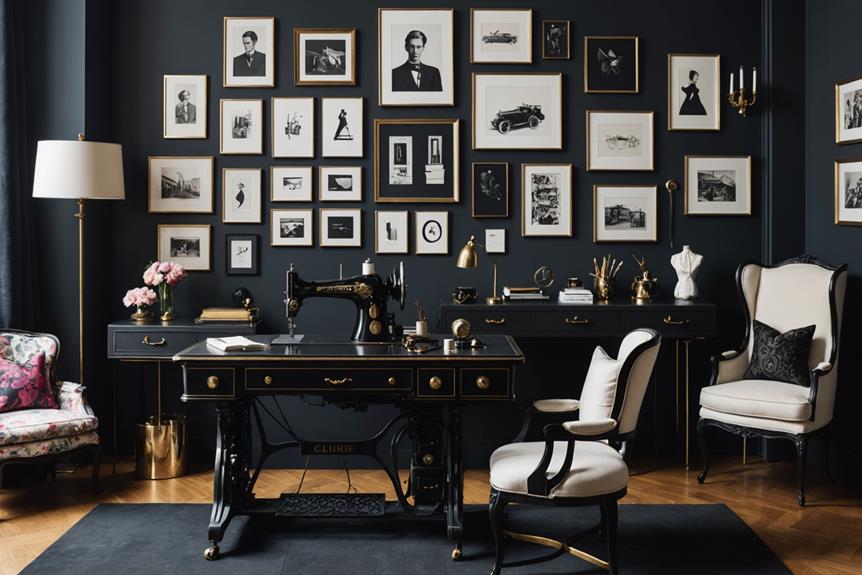Imagine a world where artistry meets commerce in perfect harmony; that's precisely what Tom Ford envisioned when he founded his eponymous house in 2005. You might wonder how a designer, already renowned for his transformative role at Gucci, could carve out a new niche in the luxury market. The journey from a revitalized fashion powerhouse to a standalone brand is not just about aesthetics; it's about a vision steeped in personal narrative and strategic innovation. So, what key moments defined this evolution, and how did Ford's identity shape the brand's trajectory?
Early Beginnings of Tom Ford

The journey of Tom Ford is one marked by ambition and transformation. Born Thomas Carlyle Ford in 1961 in Santa Fe, New Mexico, he initially studied architecture at Parsons School of Design in Paris. However, his passion for fashion led him to switch paths, and in 1990, he joined Gucci as a womenswear designer, despite his limited experience in the fashion industry. This bold move set the stage for his incredible impact on the fashion world.
By 1994, Tom Ford had risen to the position of Creative Director at Gucci, where he played a pivotal role in revitalizing the brand. His keen eye for luxury materials and innovative designs helped Gucci emerge as a leading fashion house in the luxury market. Ford's daring vision and unique style transformed the brand into a powerhouse, enchanting the attention of fashionistas globally.
After leaving Gucci in 2004, Ford took the leap to establish his own brand, Tom Ford, in 2005. His vision focused on creating a luxurious experience for his customers, combining high-quality materials with sophisticated designs.
This ambition came to fruition when he opened his first flagship boutique in April 2007 at 845 Madison Avenue in New York City. This boutique marked a significant milestone in his career, showcasing his brand's identity and solidifying his place in the fashion world.
With each step, Tom Ford has redefined luxury, leaving an indelible mark on the fashion industry.
Establishing the Brand Identity
Establishing a brand identity in the competitive fashion landscape requires more than just creativity; it demands a clear vision and a deep understanding of the market. When you think of Tom Ford, you think of a luxury label that embodies elegance and sexiness, a brand that captures attention and inspires admiration. Founded in 2005 after his departure from Gucci, Tom Ford aimed to create a fashion brand that reflected his personal narrative and design philosophy.
From the outset, he integrated a unique blend of artistry and commercial success, recognizing that fashion isn't just an art form; it's also a business. This approach laid the groundwork for a strong brand identity that resonates with a diverse demographic while maintaining mainstream appeal. The initial product offerings included a cosmetics line, launched in partnership with Domenico de Sole, which helped set the stage for the brand's luxurious image.
In 2007, the opening of the first flagship boutique on Madison Avenue in New York City further solidified Tom Ford's presence in the high-end fashion market. This flagship not only showcased his elegant designs but also acted as a physical manifestation of the brand identity he was crafting.
With every piece and every product, you can see how Tom Ford has built a world that encapsulates sophistication and allure, ensuring that his luxury label remains synonymous with style and desirability. In this way, establishing the brand identity has become an art form in itself.
Key Product Launches

Tom Ford didn't just focus on creating a distinctive brand identity; he also recognized the importance of launching products that would resonate with consumers and elevate his luxury label. His fragrance line, which debuted in 2006, set the tone for what would become a staple in the perfume house market. The first release, "Tom Ford for Men," combined traditional and modern notes like bergamot and ginger, quickly establishing his vision of elegance.
In 2007, Ford introduced "Black Orchid," the first women's fragrance that became a best-seller almost instantly. With its unique scent profile featuring black truffle and patchouli, it captivated consumers with its dark and mysterious allure.
The success didn't stop there; Tom Ford continued to innovate with key releases, including:
- "Tom Ford Noir" for men, showcasing a sophisticated blend of warm spices and woods.
- "Tom Ford White Patchouli" for women, capturing a fresh, modern take on classic scents.
- "Tom Ford Oud Wood," launched in 2016, which brought exotic oud to the forefront of Western fragrance markets.
These luxury fragrances reflect Tom Ford's commitment to creativity and quality. As he explored diverse ingredients and experimented with various scent profiles, he not only built a successful fragrance line but also solidified his brand's reputation for elegance and sophistication.
With each launch, Tom Ford continues to redefine luxury in the perfume industry, making his offerings highly sought-after by fragrance enthusiasts around the world.
Expansion Into Cosmetics
Frequently seeking to innovate, Tom Ford ventured into the cosmetics domain in 2005, launching a line that quickly garnered attention for its high-quality products. Partnering with Domenico de Sole, he crafted an impressive array of cosmetics and fragrances that captured the essence of luxury. This bold move marked a pivotal moment for the Tom Ford brand, solidifying its reputation in the beauty industry.
In April 2007, the first flagship boutique opened at 845 Madison Avenue in New York City, serving as a stunning showcase for Tom Ford's luxurious offerings. The boutique not only elevated the brand's image but also provided a physical space for customers to experience the exquisite quality of the products firsthand.
As the years went by, Tom Ford Beauty grew rapidly, achieving estimated sales of $1 billion by 2017. This impressive figure demonstrated strong market demand and highlighted the brand's appeal among beauty enthusiasts.
Tom Ford's cosmetics line includes best-selling items like lipsticks, foundations, and eyeshadows, celebrated for their luxurious formulations and chic packaging. Each product reflects the brand's commitment to quality and sophistication, attracting a loyal following.
Acquisition and Future Direction

The acquisition of the Tom Ford brand by Estée Lauder on April 28, 2023, for $2.8 billion marks a significant milestone in the luxury beauty landscape.
This strategic move not only enhances Estée Lauder's luxury portfolio but also paves the way for exciting developments in the Tom Ford universe. With Zegna Group gaining full control of Tom Ford International and securing a long-term licensing agreement, you can expect a fresh direction for both the fashion line and Tom Ford Beauty.
Here's what you can look forward to in the coming years:
- Sales Growth: Projections indicate that Tom Ford Beauty could reach $1 billion in sales, showcasing the brand's massive potential.
- Creative Direction: After Tom Ford's departure, Peter Hawkings has stepped in as the new creative director, bringing a fresh perspective to the brand.
- Innovative Collections: Haider Ackermann is set to debut his collection in March 2025, promising exciting new designs that resonate with the brand's luxury aesthetic.
Estée Lauder's ownership is set to maintain Tom Ford's exclusivity while expanding its product availability in the luxury market.
This means you'll see more innovative products that uphold the brand's reputation for sophistication and quality.
With a strong focus on creativity and sales growth, the future looks incredibly bright for Tom Ford, ensuring that the brand continues to captivate audiences worldwide.





Greetings! Very useful advice within this article!
It is the little changes which will make the most important changes.
Many thanks for sharing!
Thank you a lot for sharing this with all of us you actually realize what you are talking approximately!
Bookmarked. Please also seek advice from my web site =).
We will have a link exchange agreement among us
Excellent, what a web site it is! This webpage presents
valuable information to us, keep it up.